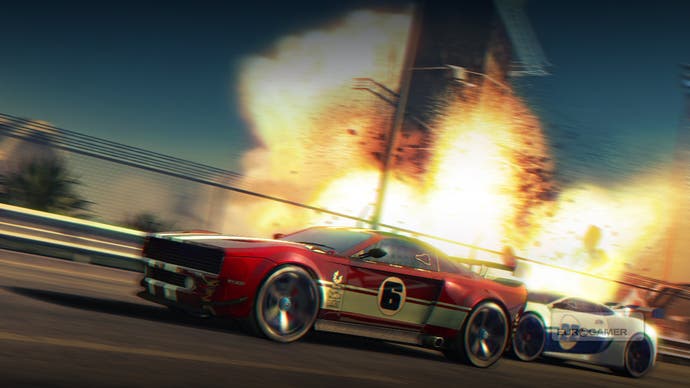Split/Second
Handling with care.
The latest builds of the game also do a better job of visually justifying the things that happen to you. When you're knocked sideways by the edge of an explosion, for example, there's a visible impulse wave that breaks over you. Dust also clouds across the track obscuring your vision in the aftermath of a building collapse, and objects scattered around the base of a detonation are strewn across the track. While there are still apexes to look out for and key layout changes to note and react to on subsequent laps, the dynamic debris and particle effects give you more than just the opposition cars to worry about.
Split/Second's core idea also means that Black Rock can change things up considerably between environments, and even between different tracks set in the same area. "I think sometimes, when people ask questions about tracks and you say you're creating multiple tracks in the same environment, they wonder about how much re-use there is, and hopefully this shows that they're in the same environment but they're very different tracks," says Baynes. It certainly does. The docks move away from the airport level's emphasis on explosions, collapsing buildings and flying objects, toward containers being whipped around on loose crane cables instead, and huge ships coming into play several times across the different routes. On one lap you race under a tanker in dry dock with very little vertical clearance; on the next lap you drop it on someone's head, and the route changes to take you through the interior.
Baynes also hints at other game modes besides the core single-player campaign, which will play out as a TV season of 24 episodes, each with a unique make-up of events. He won't say what the other events are, but it's easy to imagine where they might go. "When you do other game modes, more often than not they're built around the core game mechanics, just being treated in a slightly different way," he says. "Look at all the modes in Gotham - they're using the standard game mechanics, just changing the rules. Because we've got a unique mechanic for a racing game, it's given us some unusual ideas for modes. It's been interesting."

Those other modes may also factor in to how Split/Second handles campaign difficulty, and again it's about balancing variety against accessibility. "What we want with this game is that people don't hit big barriers where you have to be hardcore to complete it," says Baynes. "There's lots of secrets to unlock, and new vehicles and powerplays to unlock, and game modes that spin off from the main TV season - and they're the kind of thing you get if you're a Eurogamer reader and go through and finish first in episodes." What a suck-up.
As for multiplayer, Split/Second is now promising two-player split-screen, of which we don't see enough in modern racers, and the developer says it's approaching online modes with longevity in mind. But what does that mean? Perks? Unlockable Alsatians running alongside the car? "Games like Modern Warfare are being played online a year after release, and a lot of racing games don't have that, so we've looked at things online so there's a reason to go back weekly, and a reason to go back and try to progress in a certain way." Woof. One way of keeping people connected may be ratings on crashes, which Black Rock hopes to let you record and share.
With all that in mind, I'm inclined to forgive them for throwing the original handling in the bin, and given the concept it's good to hear Baynes and Glancey restate their case about balancing the game so often and so passionately. "We've got this tool that enables us to track the way races played out [for development purposes]," Baynes mentions, just before we wind things up, "so we can see where every single car was throughout every stage of the race and at every corner: where they crashed, when they used power, which powerplays they triggered, which took them out. The goal is that with focus-testing and this we can make sure it's fair and fun. One of the knife-edge things with this game is making sure it's not frustrating, but making it feel like you're on the edge of your seat. The more we can tune that the better."
Split/Second is due out for PC, PS3 and Xbox 360 next year.



.png?width=291&height=164&fit=crop&quality=80&format=jpg&auto=webp)




.jpg?width=291&height=164&fit=crop&quality=80&format=jpg&auto=webp)
